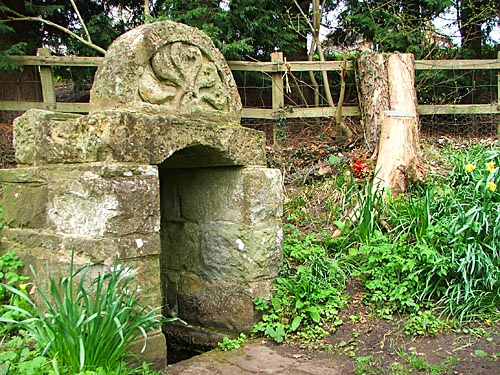|
|
|
 Speen Speen
Romans and Royalists
Somewhere in the
parish of Speen is the site of the Roman town of Spinis, meaning 'Thorny
Place,' from which the later name is obviously derived. It is the only
Roman town in Berkshire whose Latin name is known. Tradition says it was positioned somewhere near Woodspeen Farm, though
Foley Farm may remember Roman ruins used as a kind of folly. It was only
a small settlement, but it certainly held an Imperial Posting Station or inn, where Imperial messengers
on government business were able to refresh themselves overnight. It stood on
Ermin(e) Street, the Roman Road that passed through west Berkshire
between Calleva (Silchester) to Corinium (Cirencester).
The parish of
Speen includes a number of villages including Speenhamland, Stockcross,
Marsh Benham, Woodspeen and Bagnor. Bagnor
Manor came into the hands of the Dean and Chapter of Westminster in
return for lands in St James' Park. The house is 17th century, including
a sturdy staircase, but was refronted by Thomas Harrison in the early
18th century when he rented it from them. It has since lost its upper
storey. Bagnor and its mill are mentioned in the Domesday Book (1086). The mill is still there,
dating from the late 18th century, but it does not produce flour, fulled
cloth or paper any more. It was turned into a theatre in 1965.
Speen village
itself is a Saxon hilltop settlement that developed alongside the road
between Thatcham and Hungerford, long before
Newbury was ever thought
of. The parish church was built in the valley below. By
the side of a little path between the two stands the Lady Well (see
photograph above), the best
of Berkshire's remaining medieval holy wells. It is dedicated to the Virgin
Mary, perhaps replacing an original Iron Age association with a Celtic
mother goddess. It has a charming stone cover and the water can apparently cure eye complaints,
measles and even rickets! As well as local devotees, it may possibly
have attracted pilgrims travelling between St. Swithun's Shrine at
Winchester and St. Frideswide's at Oxford.
The medieval nave
and chancel of the parish church remain, well hidden, in the north aisle
beneath an almost total rebuilding of 1860 when the south aisle became
the new nave. Shocking old photographs exist of the wanton destruction
in the name of modernisation. However, the new building is
attractive and the setting idyllic, especially when the sheep are
grazing in the churchyard. Luckily, many interesting old monuments were
reset inside: notably Jean Baptiste Castillion (1597), a Gentlemen of
the Privy Chamber from Piedmont; his daughter-inlaw, Lady Elizabeth
Castillion (1603); and the Margrave of Anspach (1806), all of whom lived
at Benham Park.
Benham Park is at Marsh Benham. It is the most magnificent classical
house, built by Henry Holland in 1774/5 for the 6th Baron Craven.
After their home at Hamstead Marshall Park burnt down in 1718, instead
of rebuilding there, his Lordship chose Benham instead. They had many
alternative houses, but liked the hunting in West Berkshire. It was
later the
home of the Margrave of Anspach and his wife. The house was modified by
Sir Richard Sutton 5th baronet in 1891 and he built the Stockcross estate
village, with pretty cottages along the main road, at the same time. Once
offices, the mansion house has now been transformed into a home once
more.
Speen was at the centre of the Second Battle of Newbury in October 1644. Prince Maurice held the area for his uncle,
King Charles I, but the Earl of Manchester arrived at Clay Hill and a fight became inevitable.
William Waller (and Oliver Cromwell) were sent to outflank the Royalists in the west. They took two days to march north around
Donnington Castle, but the the tactic paid off. The cavaliers were soon pushed back from what had previously appeared to be an
impregnable position on Speen Hill. They ascended into the village, but Waller’s men were much hampered by the field enclosures in the surrounding area and the Royalists were eventually able to escape north to Oxford.
On the Corner of Speen Lane is a stone memorial commemorating the
battle.
Speenhamland is the part of Newbury, lying north of the Northcroft Ditch
which gave its name to Northbrook Street. So the north end of
Broadway with its elegant clock, and the Bath and London Roads were
always historically in the parish of Speen. It was in this area that the
mad 18th century publisher and playwright, Israel Pottinger, grew up. The place was
always one of the most important coaching centres in the country, being
half-way between London and Bath. Thirty coaches a day once pulled in at
Speenhamland. Of the many coaching inns, only the Chequers Inn and the Bacon Arms (named after the
owners of Elcot Park) survive. The old 'Bear' was the scene of the Rev.
John Portage's trial win 1654, when he was accused of having intercourse
with spirits! This, unsurprisingly led to him being ejected from his
Rectory at Bradfield. The 'George & Pelican' became particularly
famous, when local magistrates meeting there worked out a scale for
setting poor rates that was later adopted nationally under the Speenhamland Act of 1795.
Many were the travellers who knew the old rhyme:
The famous inn at Speenhamland,
That stands below the hill,
May well be called the 'Pelican'
From its enormous bill.
This doesn’t seem to have prevented people from stopping there. It was also at this inn, in 1830, that a large crowd of mounted locals gathered in order to join
with still more mustered by the 3rd Earl of Craven at Gravel Hill near Stockcross.
They then marched on a large number of farm labourers rioting in Kintbury
as part of the famous 'Swing Riots' against agricultural mechanisation.
|
 |


 Speen
Speen

